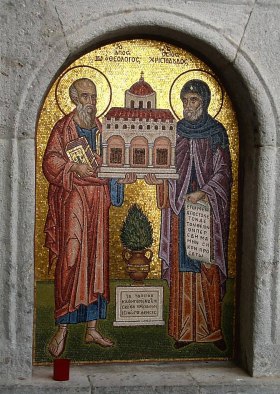Here is a testimony written by a layman, Jose Luis Lopez de San Roman from Spain, who gives his perspective on the pilgrimage.
Introduction
It is difficult to summarize everything that we lived and all that happened during seven days, from September 3 to 10, 2009. This is why I will not try to write an exhaustive report of those days, not even a detailed summary. I will recount the events that, from my personal view point, were the most important or that meant a lot to me.
We all gathered in a ship: 790 people, from 57 different countries, and many Churches and religious denominations. The ship was filled to its capacity. Many people were unable to join us, since there were no spaces left.
The majority of the pilgrims were Catholic, followed in number by Orthodox (from different Patriarchates), Anglicans, Armenians, some Evangelicals and, Venerable Suddhananda Mahatero, a Buddhist monk. He has opened an orphanage for over 600 children, where they also receive schooling. Vassula has worked closely with him in this charitable task.
Liturgies
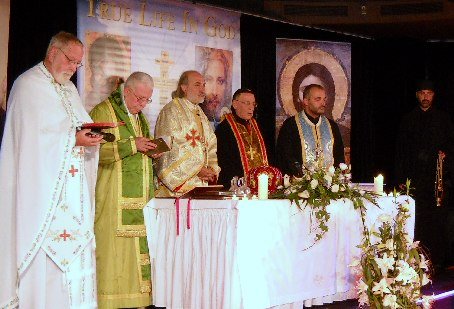
Everyday there was Holy Mass in different rites for all the Pilgrims, mostly aboard the ship.
On Friday September 4, the Catholic Holy Mass presided by Cardinal Toppo from India, four Bishops (two from India, one from Peru and another one from Brasil) and over 60 Catholic Priests. It was impressive. All of the Pilgrims were united in one same spirit and devotion. We were sharing the ‘Bread of Unity’ and there was a feeling of true brotherhood.
At the end of the Mass we always sang together several hymns, such as the Hallelujah, the Doxa Doxa, the Hail Mary from Fatima. All these hymns resounded vibrantly in a completely filled hall. The conductors were Father Otfried Chan, a priest from Taiwan, and Mezied, a Christian from Palestine, both of which attend the TLIG Pilgrimages on a regular basis. Mezied made us rejoice with his enthusiasm and joy. I loved to hear him say the Name of Jesus (‘Jeshua’, I do not know if I am writing this correctly), while he lifted his hands up to Heaven.
On the afternoon of that first day, there was a procession of all the attending clergy, all of whom introduced themselves, one by one. Overall, there were over one hundred members of the clergy including the Cardinal and 15 Bishops and Archbishops. There were many priests that wanted to attend the Pilgrimage but were not able to do so for several reasons.
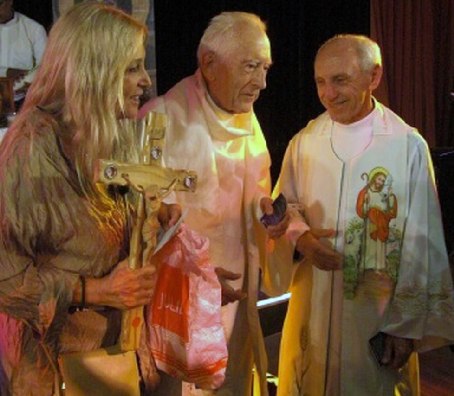
Father Rene Laurentin was the most applauded since we all stood up to express our acknowledgement and affection for all the years he has been accompanying, supporting and defending Vassula. It was very touching.
On Sunday September 6, there was a Greek Orthodox Divine Liturgy at the amphitheatre of the Apocalypse grotto on the Island of Patmos. All of the Orthodox Clergy co-celebrated. Father Eugene Pappas explained that the Liturgy was written by Saint John Chrysostom, a Saint venerated both by Orthodox and Catholic alike. As I am beginning to write this report, I notice that today, September 13, is the Feast of Saint John Chrysostom.
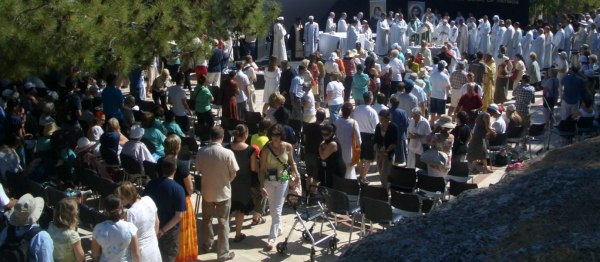
Amphitheatre of the Apocalypse grotto on the Island of Patmos
The Divine Liturgy was entirely sung filled with praises and petitions to God, all in different languages (English, French, Portuguese), in accordance with the language spoken by the celebrating clergy.
The Orthodox continue to use incense, which I personally like very much. I also appreciate the way they pronounce the word ‘Sacrifice’, as they declare, clearly and unequivocally, that the Mass is the Materialization of the Sacrifice on the Cross.
Honestly, I followed the Divine Liturgy with great devotion and enjoyed listening to the portions that I understood (Portuguese and French) and I did not feel that it was too long, at all.
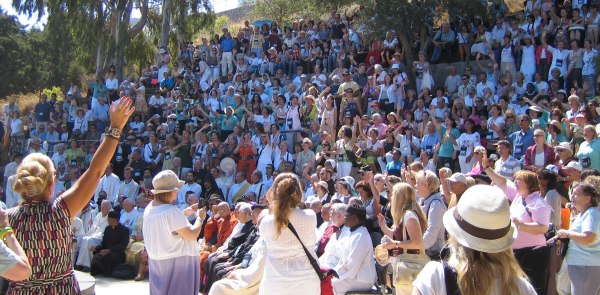
At the end of the Liturgy, all of the religious articles that the pilgrims had left before the altar were blessed with Holy Water and finally a photo was taken of all the Pilgrims while we all sang ‘Doxa, Doxa’, united in one heart.
At the end of the Liturgy, all of the religious articles that the pilgrims had left before the altar were blessed with Holy Water and finally a photo was taken of all the Pilgrims while we all sang ‘Doxa, Doxa’, united in one heart.
On Monday September 7, an Armenian Orthodox Divine Liturgy was concelebrated by several archbishops, bishops and priests from the Armenian Church (I believe there were a total of five). The whole celebration was sung of course.
Next day, Tuesday 8, we had the Greek Orthodox Divine Liturgy, although the Orthodox call it Greek-Catholic. It is my understanding that the Orthodox Church is ‘Catholic, Apostolic, and Orthodox’ (Catholic means universal; Apostolic because they are successors of the apostles; and Orthodox, because they keep the right and authentic doctrine). Obviously, the Divine Liturgy was celebrated in Greek. Fr Pappas also told us that the Creed sung in the Orthodox Liturgy was originally written in Greek language.
On Wednesday September 9, there was Holy Mass celebrated under the rite of the Maronite Church. This is part of the Catholic Church, but an Eastern rite. It was concelebrated by a bishop and several priests, in Aramaic language, and it is similar to the Catholic Mass with hymns, prayers, petitions, and praises that are common in the East (which, I insist, I like them although I do not understand them). To conclude the Pilgrimage, on Thursday 10th, we had Catholic Mass for the third time.
Eucharistic adoration
On Sunday, September 6, all of the pilgrims assisted to Eucharistic Adoration. Prayers and intentions, moments of silence, songs of praise and adoration were alternated and guided by a priest. At the end, Mgr Kriekenbeek walked by with the Blessed Sacrament practically in front of each one of us. Some people fell ‘slain in the Spirit’. It was awesome, there was a lot of fervor, many eyes filled with tears and above all, lots of love to the Eucharistic Presence of Jesus.
The priest took the Blessed Sacrament to an improvised Chapel in the upper part of the ship and placed It on the altar. There was continuous adoration for four days. Time shifts were planned in order for the Lord to be always accompanied. There were moments in which the chapel (that was large) was practically full. There, I saw my Orthodox brothers, both laymen and clergy, worshipping Jesus as we did.
As my wife told me repeatedly: ‘that was the best place of the ship, the place where one felt at its best’. And it is true. The light was faint, the sea could be seen through the large glass panes, the floor was carpeted, and there were some small chairs to sit with Jesus. There was a sense of well being, and many people spent hours and hours there, both during the day or night.
On Wednesday September 9, a time of Eucharistic Adoration was arranged for all pilgrims, just as the one of Sunday, September 6. It was the farewell. The Blessed Sacrament remained in the Chapel until midnight while we prayed, adored and sung together. The priest ‘reserved’ the Holy Sacrament.
My God, what emptiness afterwards! How filling is the Eucharistic Presence of Jesus! We had been so well there!
I also want to mention Confession. Fr. Pappas, Archimandrite of the Greek Orthodox Church, invited all of the pilgrims to Confession. Several priests sat around various places on deck to hear Confessions. With two chairs, a confessional booth was improvised, and Orthodox and Catholic priests confessed the pilgrims.
I was surprised to see that when granting the absolution, the Orthodox priests placed their stole over the head of the penitent.
Meetings
This seems to me much more difficult to summarize, but at least I will try to give a general overview. Every evening, there was a meeting for all of the pilgrims, in the large hall of the ship. Vassula, and those priests, bishops and archbishops who willing wanted to do it gave speeches to those attending. Vassula always started the meetings, acting also as master of ceremonies to ensure that everybody participated. The first day, she opened the meeting by reading a Message of Jesus about Unity: ‘The Center of My Church is the Eucharist’.
Vassula also asked the following question:
‘What do the other Churches lack, for example the Orthodox Church, to be in ‘full communion’ with the Catholic Church?’ Those of us meeting here today, do we live in ‘full communion’?’
There were many responses, some of them really interesting. As the majority of the pilgrims were English-speakers or understood English, and only some of the interventions were translated into French, I had a lot of difficulties to understand or grasp what they said.
I was able to clearly understand that the ones that ‘suffer’ division the most are those members of the clergy that minister in places where different Churches and Christian communities coexist.
One bishop (I do not remember his name or the Christian denomination to which he belongs), referred to the possibility that the next Ecumenical Pilgrimage takes place in the Holy Land. ‘At first I thought that this would be an unwise idea, since all, absolutely all, of the divisions of the Christians are present in the Holy Land. However, today, after seeing our union and brotherhood, I think that it would be a great testimony, if everybody could see Catholics, Orthodox, Anglicans, Armenian, etc. united and holding hands, seeking and already living an ‘advance’ of the Union, of the Unity, of the Churches’.
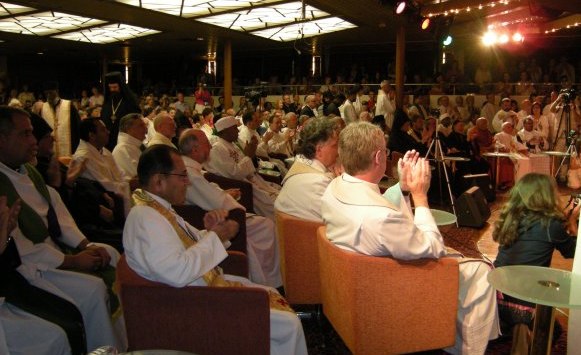
Likewise, Bishop Riah, an Arab Anglican Bishop from Jerusalem, declared that he suffers in his own flesh the sadness of the division of the Christians, right in the City in which Jesus died and resurrected, and from where He rose to Heaven.
Bishop Isidore, an Arab Bishop from Syria living in Damascus described a similar scene, in Damascus, where Paul found the ‘Light’. Bishop Isidore has been working for Unity for many years. He was with John Paul II on his visit to Damascus, and the two of them shared the fervent desire to achieve Unity. ‘All of us who have met here are different, but we have a common denominator: all of us love and want Unity’.
Fr. Vladimir Zielinsky, a Russian Orthodox priest, and Fr. Rolf, a Swiss Catholic priest, that work for Unity in Russia and Ukraine spoke. Fr. Zielinksy spoke of the terrible persecution that the Orthodox Church suffered in Russia, since 1918, under the Communist regime. A renewal can be seen now: churches and seminars are re-opened, vocations are blooming, people are returning to their rites and prayers. ‘I know more than one hundred miraculous icons of the Holy Virgin Mary in Russia. Unity must be lived by sharing holiness, finding Christ in other people’s faith’.
Fr. Rolf, the Catholic priest, spoke of the great obstacles that Catholic priests find in order to work in Russia. Those who work for Unity are persecuted and are at risk to be excluded from their Churches. He spoke of a priest, who was murdered not many years ago, because of his work for Unity. Father Rof also offered his life to the Holy Virgin Mary for the sake of Unity. What impedes you to offer yourselves completely to Unity? It is not enough to pray and fast, one must be willing to give his own life too.
Father Laurentin also spoke and declared that those of us who were present were really united in spirit, in love and in charity.
Father Ibanez (from Argentina) expounded on the subject and quoted Saint Paul’s letter to the Ephesians, Chapter 4: ‘…there is one Body, one Spirit… There is one Lord, one faith, one baptism, and one God and Father of all, over all, through all and within all.’ It was a very interesting intervention.
Someone else also referred to Chapter 9 of Saint Mark’s Gospel with respect to the complaint of the disciples because ‘others’ cast out devils in the name of Jesus and they were not ‘one of us’. We all know Jesus’ answer.
Many spoke of Unity in the diversity. Unity has to begin in the heart. Unity will only be achieved with humility and love.
Several Orthodox priests, from Ethiopia, made a happy contribution by showing the first volume of True Life in God in Ethiopean published in their country. ‘On September 12 a new phase in the history of Ethiopia begins, because we will return with more strength than ever before’.
Father Jozo, who was the first defender of the Holy Virgin Mary’s apparitions in Medjugorje, was unable to attend the pilgrimage at the last minute. His assistant, a Croatian lady named Vesna Cuzic, was there however and Vassula gave her a beautiful icon of Our Mother as a gift for Father Jozo. Vesna said that Father Jozo told her that ‘the Messages of the Holy Virgin Mary in Medjugorje and True Life in God are the graces that are given to the Church to us today to find the way to Christ Our Lord‘.
I want to highlight that all of them extolled and valued Vassula’s mission, a tireless fighter for Unity. Her path is rough, but there are fruits, positive and promising fruits that do not please Satan, the ‘divider’, the one that separates, the one that splits.
God is Unity in the Trinity, Jesus wants Unity: ‘May they all be one, just as, Father, You are in Me and I am in You, so that they also may be in us, so that the world may believe it was You who sent Me’ (Jn 17, 21). Satan seeks division, separation, rivalry. This is why he furiously attacks Vassula, because she is the prophet of Unity, an instrument of union.
Sharing Together
If in any Marian sanctuary, one of the most positive aspects is sharing the affinity of ideas and goals, the love for Jesus and Mary, what to say of a ship, where we all were pilgrims and breathed the same feeling to follow Jesus, to do His Will, to be His apostles…?
We were not angels, but people of flesh and blood, with defects and limitations. However, we tried to give the best of ourselves, to know ourselves better and to learn and enrich from the experiences of the others. We really formed one body. ‘Surnames’ were not important. I never thought to ask: ‘Are you Catholic or Orthodox?’ Anyone by my side was my brother.
In spite of the linguistic obstacles (I do not speak English), I was able to communicate with very different people. I had the grace to be able to greet Bishop Joao Terra, a Brazilian Bishop, who has received Vassula in his Diocese, several times.
I spoke with Armenian Orthodox Archbishops, and with many priests. I talked with an older French priest, who has been part of the Community of the Beatitudes for over fifteen years and who believes in Vassula, he is a reader and admirer of Father Laurentin and that is how he learned about Vassula. He referred to Vassula as a prophet of our times. This is exactly how I introduce her in a Church in Madrid, on October 1995.
I also had long conversations with a young Croatian priest, who was always happy and smiling and with a young Croatian who lives near Medjugorje where he goes frequently (He told me he had just been there). We shared a lot. I also talked with Father Otfried, priest from Taiwan, whom I have known for several years and for whom I have a great affection.
There were several bishops and priest from India, for which I felt a great admiration. I could barely speak to them, but at least we greeted each other and I received their blessings. From the face, the behavior and the attitude, they seemed to me like real saints. They were frequent attendees at the ‘Adoration Chapel’ which was improvised on the ship.
I talked and shared a lot with the other lay pilgrims, since I could be having breakfast with a couple from the United States, or Italy, Ireland, or Denmark, or lunch with Japanese families, or from South Africa, Australia, Canada or the Philippines. Some had brought their small children with them.
While on land our means of transportation were 18 buses, two of which were only for young people as there were many of them. As a matter of fact, some of them have formed a music band, composing music for certain passages of the True Life in God Messages. They had a performance for all of the pilgrims on the ship, and frankly, they are very good. The band is composed by six members: one German, one Japanese, and four Greeks. The singers are two girls and the guy who is also a guitar player. Their voices are very good. The repertoire includes many well known religious songs. They do public performances in order to attract both the young and the not so young. It is a very convincing and current way to be apostles of our times.
And what can I say of our brothers from Latin America? In our bus (we always drove in the same one), there was an Armenian Archbishop, who lives in Argentina, a Catholic bishop from Peru and four priests, three from Spain and one from Argentina. In this bus, there were pilgrims from Spain, Argentina, Mexico, Peru, Colombia and Uruguay (the ones from Venezuela were in another bus, as there were two buses for the Spanish speaking pilgrims. You could find well prepared people, very pious and devoted, really admirable.
We took advantage of the journeys to pray and give testimonies. We prayed the Rosary, the Chaplet of Mercy, listened to the ‘talks’ of Father Ibanez and shared testimonies. We were a family.
Now, in spite of the distance, I remember them fondly and miss them. What a great group we were! Bishop Raimundo Revoredo from Peru, who celebrated the last Holy Mass in Spanish, was always smiling. Smiling was the usual sign among us. How easy it was to smile there! I prefer this loving and open smile that the dull and empty laughter that abounds so much in the world.
Pilgrimage
Although the Pilgrimage was entitled: ‘In the Steps of Saint Paul’, the truth is that what impressed me the most was the Apocalypse grotto in the island of Patmos.
The grotto was filled with the presence of Saint John, apostle. This is what many of us felt, as we did not want to leave the grotto. I felt the presence of an elderly John, with tired eyes, weak legs, but filled with God. John, the ascetic, the mystic. Accompanied only by his disciple Procorus, to whom Saint John dictated the visions he saw.
Fr Pappas compared Fr. Laurentin with St. John, apostle. Fr. Laurentin, who also has difficulties to see and walk, was also accompanied by a young man. The comparison was very accurate. Fr. Laurentin has a clear and sharp mind.
I felt that I do not remember St John often enough. He was the favorite apostle of Jesus, the one who leaned his head on His Chest, the one who accompanied Him until the foot of the Cross, and saw Blood and Water gush out of His Side. He saw Jesus when He resurrected, recognized Him from his boat: ‘It is the Lord!’, he watched Him ascend to Heaven, and then accompanied Mary until the end of Her days on earth. I asked him for a spark of his Faith, of his apostolic zeal, and, especially, of his great love for Jesus and Mary.
I was also impressed by the island of Lesvos. We visited two churches there. The first one was small and dedicated to Saint Raphael, Nicholas and Irene, three saints that were martyred by the Turks in 1463. They have recently appeared to many people, reminding them of their martyrdom and indicating the place where they were buried. Thanks to these indications, their relics were discovered in 1960, and are located in this church.
The Monastery of the Archangels of Mantamado is located some miles away. In the XI century, the Turks took the Monastery by assault and killed all of the monks. One of them managed to escape and invoked Saint Michael, who saved him from the attackers, slaying all of them. This monk, named Gabriel, made an icon of the face of the Archangel Saint Michael, with the fresh blood of his martyrized brothers, with white powder and soil. This icon is kept and venerated in this Monastery.
The hanging monasteries of Meteora, in Volos, are also worthy to be admired. They are built in the mountains, in places almost impossible to access, as a refuge from the attacks of the Turks.
Obviously, the places we visited the most were those related with Saint Paul: mount Aeropagus in Athens, Philippi (on the island of Kavala), where he baptized Lydia.
In Thessalonica, we visited the Church dedicated to Saint Demetrius, a Roman officer who embraced the Faith in Jesus and was martyred. He is now the Patron Saint of the City.
What struck me the most about Saint Paul was his courage and strength: despised, insulted, beaten, condemned, imprisoned, expelled… What a good example for all of us in True Life in God, who want to be true apostles of Jesus and work for unity! John, apostle of the East; Paul, apostle of the East and West; two role models for all of us.
Conclusion
I have been in many Marian Shrines and Apparition Places (Lourdes, Fatima, Medjugorje), but this was different, something unique, exclusive to True Life in God: the gathering of 800 people, Catholic, Orthodox, Anglicans, Armenians, living together for one week, meeting each other better, praying together, talking and putting the Eucharist into the Center of our spiritual life. The Most Holy Trinity is Family and Unity. We felt as a family and close, like one persons. We really felt like brothers and that feeling increased with the passing of the days.
One ship where we all had one heart and one soul (Acts 4,32). Some of us had the Rosary around our necks; some were wearing visible Crucifixes or medals (especially those with the Holy Face); some wore t-shirts with the Face of Our Lord; others with images of Our Lady, and everyone had, at all times, a quick smile ready to greet and welcome…
I have already participated in the 2000 TLIG Ecumenical Pilgrimage to the Holy Land and the Ecumenical Retreat in Barcelona (2006). I see now that, in spite of the difficulties, hindrances and obstacles, Vassula’s mission is bearing fruit, growing and strengthening.
It has been very difficult for me to ‘disembark’, return to normal life. I miss the ship, the Chapel located on the top deck, the sung Masses, with no rush, the smell of incense, the company of my brothers, especially those of bus 6.
When remembering the Pilgrimage, three words come to my mouth: ‘Thank you, Lord’. Thank you for those unforgettable days! Thank you for this wonderful experience! Thank you, Lord!
Jose Luis Lopez de San Roman


